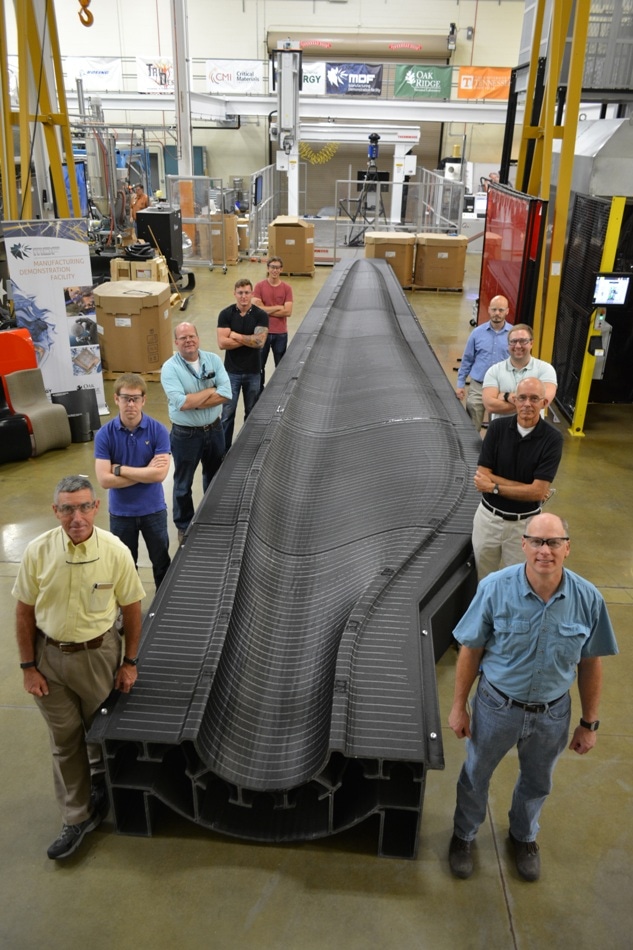Nov 15 2018
Sandia National Laboratories has designed the first wind turbine blades made from a 3D-printed mold, which could significantly reduce the time and cost of developing innovative wind energy technology. For this achievement, Sandia has been conferred with the National 2018 Technology Focus Award by the Federal Laboratory Consortium for Technology Transfer.
 Sandia National Laboratories collaborated with Oak Ridge National Laboratory’s Manufacturing Demonstration Facility Team on a 3D-printed wind turbine blade mold. (Image credit: Brittany Cramer, Oak Ridge National Laboratory)
Sandia National Laboratories collaborated with Oak Ridge National Laboratory’s Manufacturing Demonstration Facility Team on a 3D-printed wind turbine blade mold. (Image credit: Brittany Cramer, Oak Ridge National Laboratory)
In addition, the labs received FLC’s Excellence in Technology Transfer Award for advanced nanomaterial window films with the potential to save billions in energy costs for consumers, annually.
These two deserving collaborations align well with Sandia’s mission. They strengthen our nation’s energy security and resilience by lowering the cost of energy technologies.
Jackie Kerby Moore, Manager of Technology & Economic Development & Sandia National Laboratories' Representative to the Consortium
The recipients were honored at an award ceremony held on April 25, 2018, at the national meeting of the consortium in Philadelphia, Pennsylvania.
3D Printing Accelerates Wind Tech Innovation
For 40 years, researchers at Sandia National Laboratories have designed wind turbines that are more efficient in harvesting energy than the existing technology, thereby cutting down the renewable energy cost. However, it is quite challenging to create prototypes. Each prototype needs a sequence of labor-intensive, tailored molds that can take nearly 16 months for completion before the blade can be constructed and assessed.
Sandia headed a collaboration that showed a means by which this time could be minimized to just three months. Sandia could successfully 3D print the mold directly from a digital design, cutting down over a year of production time, by partnering with Oak Ridge National Laboratory, a leader in the field of 3D printing, and TPI Composites, the nation’s largest independent producer of wind turbine blades. While the demonstration focused on a comparatively small 13-m blade, it can be scaled up for applications in industry; designers could experiment with their designs and speed up advancement in wind technologies.
Sandia’s joint effort to tackle a vital energy-related issue has been honored with the 2018 Technology Focus Award. Sandia headed the design of the blade, including a review of the practicability of using additive manufacturing. After consulting on the mechanical parameters, TPI carried out the computer-aided design geometry and the structural design needed to effectively mold the blade. Oak Ridge printed the mold in various sections within just a fortnight, while the finishing assembly and production of the blade were performed at TPI.
“The wind department at Sandia has expertise is designing blades, but our group doesn’t work with additive manufacturing,” noted Josh Paquette, Sandia researcher. “This project was an opportunity to combine expertise from two laboratories and an industry adviser that could immediately bring this knowledge into the private sector.”
Nanotechnology Keeps Windows Cool in the Summer, Warm in the Winter
According to the Advanced Research Projects Agency-Energy, in the United States, almost 30% of all window glass in the Midwest and northern states are single-pane windows and about 40% in the South. These poor insulators are collectively responsible for the loss of an incredible amount of heating and cooling energy. Sandia has collaborated with Santa Fe, New Mexico-based IR Dynamics to develop advanced nanoparticle films that improve the energy efficiency of windows, thereby saving nearly $12 billion annually for American consumers and dramatically reducing national energy consumption.
The IR Dynamics-Sandia team used nanoparticles of the compound vanadium dioxide to produce the films. Some materials (for example, aluminum) reflect heat and light, while others (for instance, glass) transmit them; vanadium dioxide is temperature-sensitive (thermochromic) and both reflects and transmits light and heat. In response to the temperature, the nanoparticle films transition from being heat-transparent to being heat-reflective.
Since the application of an energy-efficient film might possibly be considerably less expensive than a complete window replacement, the consumers would reap more savings sooner.
The FLC award recognizes the efforts of the Center for Integrated Nanotechnologies as an incubator to support transfer of licensed Sandia technologies to the private sector. We have received strong support both from CINT and from Sandia’s technology transfer office, including Cooperative Research and Development Agreements and New Mexico Small Business Assistance, for small-business nanotech collaborative development.
Paul Clem, Sandia Engineer
CINT is a DOE Office of Science user facility, operated by Sandia and Los Alamos National Laboratory.
3D printed casting molds and heat-sensitive nanoparticle films are great examples of how Sandia’s scientific research translates into products that benefit the public, and at the same time enable our missions. These partnerships are important to Sandia’s contributions in energy security, reliability, and efficiency. We look forward to engaging with additional partners to make these and other innovations more widely available.
Mary Monson, Senior Manager of Technology Partnerships & Business Development - Sandia
The Federal Laboratory Consortium for Technology Transfer is a nationwide network of over 300 members that offers a platform for the development of approaches and opportunities for connecting laboratory mission technologies and expertise with the marketplace. The awards program annually acknowledges federal laboratories and their industry partners for excellent technology transfer efforts. From the time it was established in 1984, the organization has honored almost 200 federal laboratories, becoming one of the most coveted honors in technology transfer.